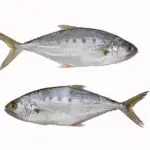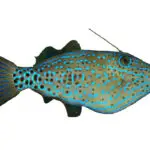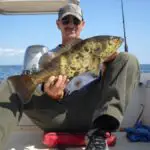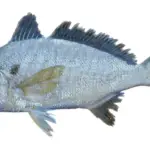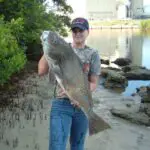While jack crevalle can live in both inshore and offshore habitats, many people have reported seeing them in freshwater environments…
This begs the question, can jack crevalle really live in freshwater?
Table of Contents
- Can Jack Crevalle Live In Freshwater?
- How Can Jack Crevalle Live in Fresh Water?
- What Is the Preferred Habitat of Jack Crevalle?
- Where Can You Find Jack Crevalle in Freshwater?
- Related Posts
Can Jack Crevalle Live In Freshwater?
Jack crevalle are known to inhabit brackish waters, with some fish being found further upstream in bodies of freshwater. While these are rare occurrences, jack crevalle are a hardy fish and can withstand different water salinities in order to survive.
For example, on the east coast of Florida where I live, we have the Indian River Lagoon which is a shallow brackish estuary.

Jack crevalle are plentiful in this area, and it is not a pure salt environment. Additionally, we have creeks and small rivers that start as freshwater, and slowly increase salinity as they meander toward the coast.
Jack Crevalle are known to swim up these brackish rivers and creeks for miles, far away from the salty coastline.
Can Jack Crevalle Live In Freshwater Lakes?
Lake Pontchartrain in Lousianna is a large brackish lake and jack crevalle are a common catch.
Other lakes in Florida that are part of the St. Johns River system and Apalachicola River system are known to occasionally report catches of jack crevalle.
Usually, these fish find their way into lakes during periods of highwater, flood, or through networks of canals and creeks that lead back to a saltwater source such as a bay or coastline.
You May Also Like: Can Mullet Live In Freshwater?
How Can Jack Crevalle Live in Fresh Water?
Jack crevalle are considered euryhaline organisms. These are creatures that can adapt to different water salinities in order to thrive.
Fish that can do this are often found in brackish water, which is water that has more salt than freshwater (but not as much as seawater).
Brackish water is typically found in places such as rivers meeting the ocean (estuaries), tidal creeks and mangroves.
Fish like the jack crevalle are more commonly found in this type of water than in purely freshwater, but they have been known to travel further upstream to various lakes and rivers.
Euryhaline fish use a process called osmoregulation in order to process water and salts in their bodies. Saltwater fish tend to lose salt through their skin, while freshwater fish will tend to absorb it.
Euryhaline fish like jack crevalle, salmon, bull sharks, tilapia, and sturgeon can regulate the salt content in their bodies to be able to survive in freshwater environments.
Jack crevalle are one of the most plentiful species of euryhaline fish. Younger fish have been found in areas with salinities between 35.2 to 36.6 parts per thousand (ppt), while most adults that are found in freshwater tend to prefer a salinity of around 43.6 ppt.
Jack crevalle are not usually found in water that has a salinity level of 30 ppt or lower.
What Is the Preferred Habitat of Jack Crevalle?
While jack crevalle can live in bodies of freshwater with very low salinity, this is not their preferred habitat. Jack crevalle are a saltwater species and live in both offshore and inshore environments.
Larger adults tend to favor the deeper waters more so than young and juvenile fish.
When looking at the inshore environments, jack crevalle like to hang around places such as sand bays, shallow reefs, open beaches, shallow flats, lagoons, and thick grass beds.
Those that stay in the deeper waters tend to live in depths of around 50 to 200 meters.
Jack crevalle are very adaptable fish, so they can be found just about anywhere as long as the water temperatures are warm enough. Plentiful food sources are the most important thing when it comes to the preferred habitat of jack crevalle.
Jack crevalle are fast swimmers, and often swim in schools following seasonal bait migrations like the mullet run.
Where Can You Find Jack Crevalle in Freshwater?
Jack crevalle can be found in almost every tropical or temperature environment in the Atlantic ocean. This ranges from the southeastern United States coastline all the way to western Africa and Europe.
In the west, they can be found in the greatest numbers around the southern United States and Mexico all the way down to Uruguay.
These fish can be found in any brackish waters or freshwater estuaries in these areas. The most common place where this occurs is in states such as Florida, Louisiana, and Texas.
It is not uncommon to hear about good numbers of jack crevalle found in streams, rivers, and even lakes throughout Florida.
Heck, in my area alone I’ve caught them in storm-run off canals and retention ponds!
Most anglers are not fishing these areas in search of jack crevalle, and are instead generally looking for other species such as bass, or trying to cast net mullet for bait.
When they catch a jack crevalle in this environment, it is usually a surprise but more than one can usually be caught as these fish like to travel in schools and love to take artificial lures.

Growing up in Florida, I’ve been surrounded by saltwater my entire life…and I love sharing my passion with others.
To learn more about why I started Saltwater Mecca, visit the ABOUT page.
Thank you for reading this article. Browse around & have some fun!

